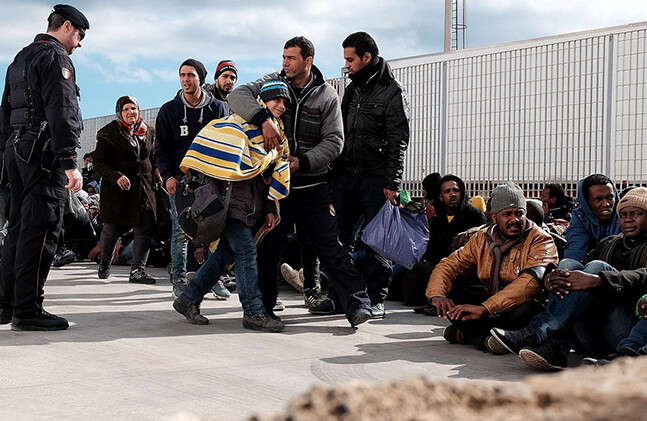It's been a deadly season in the world's oceans. Since February 2015, nearly 2,000 people have died trying to cross the Mediterranean Sea in in rubber dinghies or flimsy fishing boats. By late May, an estimated 12,800 people had spent several weeks adrift on wooden boats in the Andaman Sea and Straits of Malacca. At this very moment, as I write this in early June, many continue to die of starvation, dehydration, and untreated illness.
There are obvious parallels to be drawn between the many ways people have and will continue to die crossing the Mediterranean or Andaman Seas, the Sonoran or Saharan Deserts, atop la bestia or trapped in shipping containers. All are terrible ways to die, all the more so in this age of easy, affordable, and safe international transit. And all are directly the result of shortsighted policies that view the world's most vulnerable populations as threats to the resources and security of individual nations, and accept death on a massive scale as a useful deterrence strategy. It is not; it is at best ineffective and at worst, an unconscionable human rights catastrophe.
Every year, thousands of people die crossing international borders—in oceans, rivers, and deserts, and at the hands of soldiers, border security personnel, and unauthorized vigilante groups. In 2014, the International Organization for Migration (IOM) estimated that some 40,000 migrants have died in transit since 2000. Experts caution this is likely a third of the true death toll. If properly accounted for, migrant deaths might easily rival terrorism deaths—the Institute for Economics and Peace's Global Terrorism index reported that some 107,000 people have died in terror attacks in roughly the same time period.
Unlike terror victims, who often die in cities, and whose deaths are widely covered in local and national media, migrants often die in remote places, without documentation or witnesses who are willing or able to come forth, and their bodies are often unrecovered or too decomposed to identify. For example, In May 2015, mass graves of unidentified migrants were found in smuggler camps in Thailand and Malaysia, too late to be included in the official 2014 statistics. In April 21 2015, the IOM reported that the known death toll in the Mediterranean was 30 times the previous year's total by the same date. Yet unlike counterterrorism efforts, the response to the crisis of migrant deaths has not enjoyed a commensurate degree of international coordination and cooperation.
It is easy to heave a collective sigh as Indonesia and Malaysia agree to offer temporary shelter to some 7,000 seabound migrants from Myanmar and Bangladesh; as Thailand says it will no longer return boats to sea and that it will convene a regional conference to strategize with its neighboring countries; as the Italian coast guard reports that it rescued 2,452 migrants in a one-day, coordinated operation; as the United States reports a decline in migrant deaths along its southern border. But we should not be so easily placated. Many uncounted thousands have died and many more will continue to die if individual nations continue to pursue short-term, temporary, and ineffective policies to control undocumented migration and manage borders.
There are more migrants today than at any other time in history, and more people displaced by conflict, poverty or disaster than at any other time since World War II. Many rising economic powerhouses in the developing world—such as India, South Africa, and Thailand—have become major immigrant destinations. By the time someone arrives at the borders of the United States or "Fortress Europe," she has usually been an undocumented migrant in many other countries, and has likely been displaced or treated as an illegal person in her own home country. But the data on international migration are notoriously poor. The UN's estimate that there are some 232 million people living outside of their home countries today comes from national censuses, population registers, and national household surveys, all famously unreliable. There is no authoritative source of irregular or undocumented migration worldwide.
Political leaders in India, South Africa, and Thailand, to name a few, have all recently called migrants "illegal" or "interlopers," literally taking their rhetoric from the United States and Fortress Europe, which treat migration as a national security issue. Yet none of these countries offer legal pathways for migrants to enter and remain long-term. What we're seeing is a globalization not only of "undocumentedness," but also a globalization of anti-immigrant rhetoric.
This is damaging business. There is a direct correlation between policy regimes that re-route resources allocated for migration "management" into border security and the number of people that die attempting to cross those borders—and the United States and EU have intentionally pursued a strategy of death as a deterrent. Why should we be surprised and even outraged that Thailand, Malaysia, and Indonesia have done the same? It is through this lens that we should view these various crises—the Mediterranean migrants, the child migrants on the southern U.S. border, the boats adrift in Asia—not as discrete, isolated tragedies but as an interconnected phenomenon.
Experts agree that there is never a single reason why a particular exodus may happen. Indeed, on May 14 2015, The New York Times quoted Arakan Project's Chris Lewa saying exactly that about the spike in departures of Rohingya Muslims from Myanmar. She cited an "accumulation of setbacks," including "the tightening of fishing permits, which has hit the Rohingya monetarily and nutritionally, and the government's insistence that its one million Rohingya residents are not citizens." Countries like Syria, Libya, Eritrea, and Afghanistan, which are sending migrants across the Mediterranean, have been at war for many years; the same can be said for violence in Honduras and Guatemala before and after the spike in unaccompanied children converging on the United States in the spring of 2014.
Many have attributed these sudden spikes in people making dangerous, risky crossings to the expansion of human trafficking and smuggling operations. Naturally, with fewer safe, legal channels to cross, smugglers and traffickers become a viable option. But if this season of death tells us anything, it is that targeting smugglers is not a solution. The Italian Coast Guard has clearly stated that the EU's new plan to take military action against smugglers will not solve the migrant crisis, and that efforts should be focused on expanding search and rescue. Some have argued that Thailand's recent efforts to crack down on traffickers may in fact be one of the root causes behind this current crisis.
The only solution to the now global humanitarian crisis of migrant deaths is to merge humanitarian efforts to aid and rescue migrants in the midst of life-threatening crossings with coordinated, cooperative efforts to open safe, long-term migration channels throughout regions and even the world. Interim residential permits, such as the U.S. Temporary Protected Status, must lead to long-term solutions, and emerging types of documentation, such as municipal IDs, can offer new and flexible forms of citizenship in an increasingly urban world. Individual countries already strapped with large refugee populations, such as Thailand, Kenya or Jordan, must not be left to deal with sudden influxes on their own, let alone with the task of ensuring that these migrants find safe, secure livelihoods within their borders or through sporadic refugee resettlement programs. We must move beyond bilateral migration arrangements that push "unwanted" migrants out to neighboring countries and pursue regional, global, and other coordinated strategies for sharing the task of granting safe haven, even as we work globally to address poverty and systemic human rights abuses that displace and unleash entire populations.
There is no going back to a world in which migration can be prevented. Diasporas exist; global, linked networks of communication, commerce and transit exist; the "desire paths" that have been pounded across the globe by the estimated 30 million irregular and unauthorized international migrants in the world today exist. The best we can do is to adjust accordingly. National migration policy regimes are young, less than 50 years old and in the case of Frontex, barely a decade old. There is no reason why we cannot change how we "do" migration, moving from migration management to responding to migration realities, and reorienting ourselves away from protecting individual nations to protecting all people in a world on the move.




